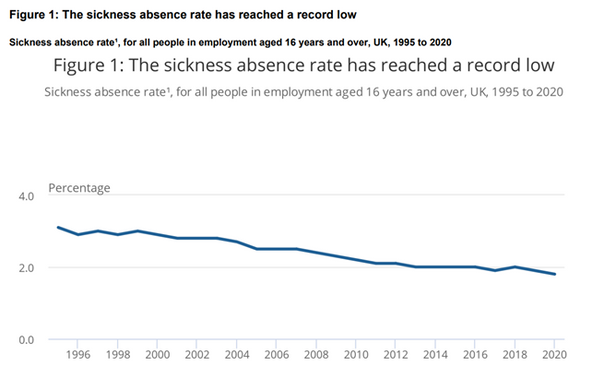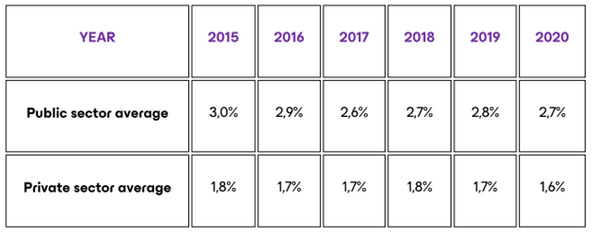Krankenstand in Deutschland
Working conditions and limitations to sick leave have been on top of the agenda in the UK in recent times. Through campaigns and surveys, private companies, public institutions, and unions have improved the physical and psychological working environment.
From a political point of view, the working environment in the UK has been a significant concern. In the post-Brexit era, the UK government has vowed not to make changes and stick to the previous hard-fought improvements, but specific proposals are still on the table to reduce workers’ rights. One detail is rest breaks for those working more than 48 hours a week.
On this page, you can read about everything you need to know about sick leave in the UK. You can get an overview of the different topics we cover in the contents table below.
Sick leave is a measuring stick that indicates how UK workers thrive when they are at work. The preliminary conclusion must be that while there is still work to do, there has been a significant downtrend from 1996 to 2020. During the pandemic, the coronavirus added new dimensions to sick leave reasons. Still, while many took sick leave because of the pandemic, other absence causes continued their downtrend due to homeworking and social distancing.
One analysis from the UK Health and Safety Executive (HSE) noted that 1.6 million workers suffer from work-related illnesses. At the same time, the cost of these health issues amounts to a staggering £16.2 billion (2018/2019. Per case, the sick leave cost reaches a total of £19,000 .
In the next section, you can read more about the severity of sick leave in the UK.
Sick leave on average
The latest data from Office for National Statistics show an overall decline in the trendline for the absence rates of workers in the UK labour market. This trendline has been consistent over the past 25 years. In 2020, the absence rate fell to 1.8%, the lowest recorded number since 1995, while coronavirus accounted for 14% of all sick leave absences.
While the curve has flattened over the past few years, we see a similar development across public and private sector workers over the last decade. However, the public sector did experience a higher percentage absence rate than the private sector, with 2.7% versus 1.6%

When looking into the average number of days absent per worker in the UK, there is also a clear downtrend. Over the past ten years, the average for UK workers has moved from 7.4 absent days per year in 2010 to 5.8 in 2020.

Sick leave on average
The sick leave absence rate is an average for the public and private sector from 2015 to 2020.
The data is from the Office for National Statistics.

Sick leave and working environment
Working conditions – both physical and mental – have a significant impact on sick leave in the UK.
However, according to Public Health England, while it shows that “good work” is good for your health, it is complex to tie the consequences of the work environment to health. Mental health is currently a high-focus area in the UK when talking about health at work. Over 14,3 million working days are lost each year due to stress, depression, and anxiety, while 1 in 6 adults have experienced a common mental health disorder over the past week. Mental health conditions have long been a contributor to long term sick leave.
Another key contributor is musculoskeletal (MSK) conditions such as back pain and mouse-related pains for workers who work long hours at their desks. In 2017, MSK issues were the second most frequent cause of absent days in the UK, accounting for over 17% of all sickness absences. In the UK, one in ten experience MSK conditions at work in UK, which equals around 28 million working days lost per year.
There is significant potential to reduce sick leave reasons in the workplace for mental and physical aspects, as there are several opportunities for improvement. In this section, you can read more about sick leave related to physical and psychological working conditions and the differences between the two types of sick leave.
Sick leave and physical working environment
The Health and Safety Executive (HSE) conducted a survey and report on MSK, its impact on working conditions, and its connection to workers taking sick leave in 2020.
Here you will find their most important findings.
1. There is, in general, a downtrend of MSK related cases. The total number of cases of work-related musculoskeletal disorders in 2019/20 was 480,000, a prevalence rate of 1,420 per 100,000 workers. In these cases, 212,000 were to the upper limbs – such as the neck and arms. 176,000 were related to back issues, while 93,000 were related to the lower limbs – legs, groin etc.
2. MSK disorders are more prevalent within manual industries such as agriculture, forestry and fishing, construction, human health, and social work activities. Whereas by occupation rates are higher among skilled trades occupations, Caring, leisure and other service occupations, and process, plant, and machine operatives.
3. The critical work factors that cause MSK are mostly workers having to conduct tiresome manual handling, working in awkward positions for a prolonged period, and repetitive keyboard and mouse-related work.

Sick leave and psychological working environment
The Health and Safety Executive (HSE) wrote a report on how the workplace impacted psychological conditions in 2020.
Here you will find their most important findings.
1. One in four people in the UK will at some point experience a mental health issue. Its severity can vary, and most will be mild, but the consequences can be serious if untreated.
2. Psychological trauma, like stress or anxiety, increases the risk of sick leave. While people have different limits on what they can be subject to, the more severe the trauma, the higher the risk of a worker experiencing long-term sick leave.
3. In the UK, employers have a legal responsibility to help their employees. Work-related mental health and workload must be measured regarding the risk of workers, and adjustments must be made accordingly.
4. Anxiety, stress, and depression are the most common mental health problems. They are often a reaction to complex life events but also be a direct work-related condition. If a worker is subject to mental health distress over a prolonged period, it can cause physical and psychological damage.

Preventing sick leave
“Sickness absence is a complex inter-relationship between people’s physical and psychological health and their work environment. There is no ‘magic bullet’, but there are ways that employers can make a difference.” writes the NHS in their 2017 report on Reducing Sickness Absence – Evidence Review.
Sick leave can be reduced further. It is important to underline, but it requires suitable precautions and a dedicated effort from the government to the individual organisations. Employers and line managers must have access to the right tools to ensure that the problems and workloads – both physical and mental – are handled accordingly and preliminary.
Preventing short and long term sick leave is about optimising both the physical and mental conditions in the workplace.
This section will state more about the efficient tools that can reduce sick leave from an employer point of view by taking a proactive approach. Sometimes, it requires little effort to tap into an immense potential. This could be through the instalment of a vertical computer mouse that helps reduce pain in the arms and elbows.
Read also: Benefits of a centred mouse.
How to reduce sick leave?
First and foremost, employers must be aware of working conditions and structures that can help discover any pains or challenges – both physical and mental – that in time could develop into long term sick leave.
Some short term sick leave can be very difficult to remove as it is often due to season-related infections and diseases such as the cold. Reversely, organisations can reduce long-term sick leave if they approach it with the right effort and strategy.
The NHS report from 2017 on Reducing Sickness Absence recommends a mix of factors to reduce employee absenteeism and proactively approach long-term sick leave.

Care conversations during sick leave
While there are not any mandatory meetings required at specific moments during an absence, it is beneficial to keep in touch with workers on sick leave.
When experiencing long term sick leave, a line manager can call the worker to a care conversation. A care conversation is not mandatory but rather a volunteering option that enables the worker to return to the workplace.
It is important to note that the purpose of a care conversation is to figure out the best way possible to keep the worker in the company. It is about finding solutions for the future that can make it possible for the worker to return in the best and fastest way possible without compromising the current illness and symptoms.
The conversation must not focus on the past but on getting a robust working relationship started again.
Possible questions for the care conversation
– How are you?
– How can we, as an employer, help you get back to work in the best way possible?
– Which needs do you need us to help you fill?
– What tools or agreements do you think could help you retain your work with us?
In long term sick leave, the care conversation is a reliable tool to set a dialogue on how the employer should help the worker get back to work. The sooner you start this dialogue, the better, while one must not force it too early in sick leave.

Tools to prevent sick leave
During the past years, organisations have become more aware of the benefits of having an ergonomic workplace, where the physical working conditions are a higher priority.
Long-term absences can be prevented to a much greater extent when a worker conducts their work in correct working positions with movements that reduce the body’s physical overload. Naturally, the work tools are essential in manual labour jobs with a great extent of physical work, but it also makes a big difference for workers who sit in the office. The fixed position behind a desk working with a mouse and keyboard strains the back, neck, and elbow significantly over a long period.
The way to relieve office workers could be with a keyboard that helps the worker achieve a more ergonomic position with arms rightly placed in front of the body. Additionally, a centred computer mouse minimises the worker’s body movement while simultaneously crafting synergy in the flow between keyboard and computer mouse.
The right ergonomic equipment and a centred mouse can reduce sick leave and increase employee productivity in one go. When employees are pain-free, they can focus on their work and keep at it for longer.

Sick leave and pay
During their work-life, most workers will at one point experience periods of sick leave in the UK. Even the group with the lowest sickness absence rate, the 25-34-year-olds, have a sickness absence rate of 1,5% of their working hours, as the Office of National Statistics shows.
A vast amount of people will, at some point, take sick leave, why we need to keep in mind how sick leave affects our pay. This correlation between sick leave and pay is what the next section will shine a light on.
Types of sick pay
What you are entitled to be paid when you are on long term sick leave varies from job to job, while there are also different sick pay schemes in operation.
If you take sick leave, you might be entitled to sick pay. Fundamentally, there are two types of sick pay available to workers in the UK:
– Company sick pay (also called contractual or occupational sick pay)
– Statutory Sick Pay
If you work in an organisation with a sick pay scheme, it is called a “company sick pay scheme”. In this case, you should be paid what you are owed under that. If you are not entitled to a company scheme, your employer should still pay you SSP – also known as Statutory Sick Pay if you are eligible.

Company sick pay
In some organisations, workers will receive a better scheme than the legal minimum requirement – the SSP. Your employer is free to offer any revised plans that do not fail to meet the minimum legal requirement of the SSP. Your details for company sick pay should always be available to you in your employment statement that you receive when you start working in an organisation.
As schemes can vary significantly between organisations, it is difficult to set a “standard”. However, sick pay schemes typically start after a minimum service period – could be a three-month probationary period.
After this, if you end up on sick leave, you will receive your regular pay up to a specific number of weeks. Once this threshold is passed, you will receive a half-pay for a further pre-set number of weeks until you become unpaid.
Under company sick pay schemes, you must present proof of sickness. Usually, you can self-certify for a week of illness before you require a doctor’s note.
Statutory Sick Pay
If you don’t have a company scheme, your employer will pay you Statutory Sick Pay (SSP) if you qualify. You get SSP for the days you would typically have worked. The first three days you are on sick leave does not provide you with SSP unless you have been on the SSP within the last eight weeks and have proven eligible once again.
Source: ACAS

Work-related sick leave
Typically, the cause of your sickness does not impact the amount of sick pay available to you. However, your employer may have unique benefits available to you in this case, so always check with them for details.
If your illness or injury happens at work, you have a legal right to make a personal injury claim. This goes for both physical and psychological injuries such as stress or anxiety. Always speak to a trade union or specialised lawyer if you consider this option.

Legislation on sick leave
For most UK residents, sick leave is a relatively but natural part of their work-life.
Sometimes, you fall ill. It is unavoidable. Luckily, it tends to happen so infrequently that the sick leave’s repercussions severely challenge neither worker nor employer. The average sick leave has been falling over the past decade. In 2010, 2,2% of all working hours were lost across the UK due to sick leave. In 2020, that number fell to 1,8%. From here, we know that workers tend to have a higher percentage of sick leave in the public sector vs the private sector.
But while you can appear healthy – both physically and mentally – you can catch a lousy fortune out of nowhere that provides new sick leave causes for a period. That is why is it always helps to have a basic knowledge of sick leave rights.
In this section, you will read about the essential information and legislation on sick leave. While we cannot cover the technical aspects of the law, we will try to bring forward the general guidelines that you should now.
Are you entitled to sick pay?
To understand whether or not you are entitled to sick pay during a long term sick leave, look at the guideline below for an overview.
– If you are a worker in the UK, you will generally be entitled to sick pay when you are on long term sick leave and unable to work.
– You must tell your employer as soon as possible if you become unable to work. Always check if your employer issues any specific guidelines in your contract.
– Your employer may ask to conduct a “return to work” interview when you go back to work. This is not a mandatory conversation.
– You will be required to show a fit note (also called a sick note) from your doctor if you are off work for more than seven days (including weekends and holidays).
– You are entitled to sick leave and if you are off on holiday. Furthermore, there are a few limited circumstances where you may still be allowed sick pay if you work abroad).
– You are still entitled to sick pay if you are on a zero-hours contract (and earn more than £120 a week, not self-employed). However, some employers may not offer you work when you are ill.
Self-employed people are not entitled to sick pay.
Source: Unison

Calculating sick leave
There are two ways for companies to calculate time lost to sickness absence – also known as absenteeism.
The straightforward formula is simply figuring out the absence percentage of total days lost to sick leave. Below, you can find the calculation to figure out how much a worker, team, or department has missed total working hours across the business. It Workerscan is a valuable tool to find outliers and focus areas:
(Total days lost / by today working days) X by one hundred = absence percentage
Secondly, there is the Bradford factor, which enables managers to assess the absence record of employees through a scoring system. With the Bradford Factor, you combine the number of sick leave spells within a given year with the total days of illness.
Absentee spells^2 x Total number of absent days = Bradford Score
How organisations evaluate the Bradford factor varies, but multiple spells due to illness increase the Bradford Score and raise a red flag.

Fit notes and proof of sickness
The worker must always provide their employer with a fit note issued by a doctor if they’ve been sick for more than seven days in a row and have taken sick leave. These seven days include non-working days such as bank holidays and weekends.
Should employees be self-isolating due to coronavirus, they can get an ‘isolation note’ online from NHS 111 so that they may refrain from entering a doctor’s office or the hospital.
A similar note will be issued by a physiotherapist, podiatrist or occupational therapist if the sickness is related to mental health. Then, it refers to an Allied Health Professional (AHP) Health and Work Report.
A fit note will usually read that a worker is either ‘not fit for work’ or ‘may be fit for work’.
In case of a ‘may be fit for work’ evaluation, the worker should discuss terms with their employer and return to work. These are conditions such as reduced hours, different tasks, etc. If no agreement can be reached on the above, the worker will be “not fit for work”.
Self-certification
If a worker is on sick leave for seven days or less, there are no requirements to hand in a fit note or other proof of sickness. When getting back to work, the employer can confirm that they have been off due to illness. This is known as self-certification.
